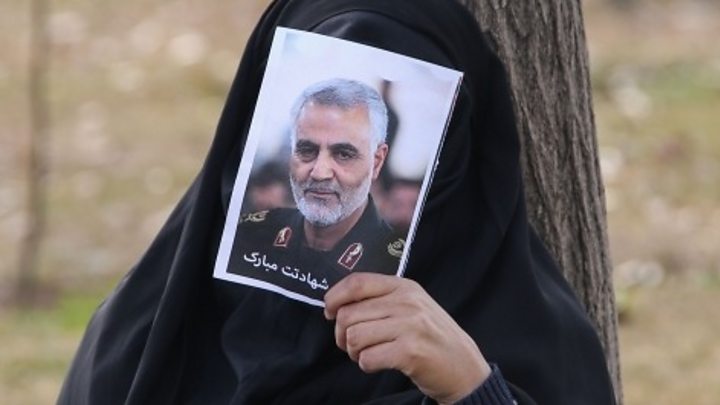Proxy forces
Despite arms embargoes, Iran has developed a modern arsenal of rockets and missiles. But if it wanted to use them against US forces as part of a reprisal, Iran would risk making matters worse. Media caption: Thousands took to the streets of Kerman to mourn Gen Soleimani, a popular figure in Iran
An act of war to answer that of the US - for example attacking US ships in the Gulf - would risk provoking a devastating response. Iran's oil refineries are on the coast and would be easy targets for the vast firepower the US has in and around the Gulf.
When Iran retaliates, it is likely to follow Soleimani's own indirect tactics: so-called asymmetric warfare, spurning an attack through the front door for one through a side window.
Soleimani cultivated a range of well-armed militias, which give Iran options short of a head-to-head confrontation with the Americans which it would only lose.
The Americans will now be looking at their most vulnerable deployments in the Middle East. One is the small force in Syria.
Media caption: Thousands took to the streets of Kerman to mourn Gen Soleimani, a popular figure in Iran
An act of war to answer that of the US - for example attacking US ships in the Gulf - would risk provoking a devastating response. Iran's oil refineries are on the coast and would be easy targets for the vast firepower the US has in and around the Gulf.
When Iran retaliates, it is likely to follow Soleimani's own indirect tactics: so-called asymmetric warfare, spurning an attack through the front door for one through a side window.
Soleimani cultivated a range of well-armed militias, which give Iran options short of a head-to-head confrontation with the Americans which it would only lose.
The Americans will now be looking at their most vulnerable deployments in the Middle East. One is the small force in Syria.
Calculated risk
A big question is why the Americans chose now to kill Soleimani. He had been a thorn in their sides since at least the US invasion of Iraq in 2003. He made sure Iraqi Shias raised, trained and equipped militias which became effective and ruthless fighters against the US and its allies. The Americans and their allies in Israel and the West have tracked Soleimani closely for years. It's likely that he has been in their sights before. The fact that this time the Americans pulled the trigger suggests that President Trump believes the reward is worth the risk, that the Iranian regime has been so weakened by isolation, economic sanctions and recent demonstrations that it will rage but not offer a serious strategic threat. Media caption: Trump - We took action to stop, not start a war
But it is not at all clear whether the assassination fits into a coherent US strategy, and such an assumption could be dangerous and wrong.
Soleimani was a colossal figure inside Iran. He was its strategic mastermind. Perhaps he left a plan of steps to take if he were killed.
This assassination at the start of a new year and a new decade might turn into another Middle Eastern milestone, touching off another sequence of bloody events.
To begin with, the Iranian regime must now be planning its answer to his death, to show that the position Soleimani spent so long creating outside its borders in the Middle East can be defended.
Media caption: Trump - We took action to stop, not start a war
But it is not at all clear whether the assassination fits into a coherent US strategy, and such an assumption could be dangerous and wrong.
Soleimani was a colossal figure inside Iran. He was its strategic mastermind. Perhaps he left a plan of steps to take if he were killed.
This assassination at the start of a new year and a new decade might turn into another Middle Eastern milestone, touching off another sequence of bloody events.
To begin with, the Iranian regime must now be planning its answer to his death, to show that the position Soleimani spent so long creating outside its borders in the Middle East can be defended.
DISCLAIMER: The Views, Comments, Opinions, Contributions and Statements made by Readers and Contributors on this platform do not necessarily represent the views or policy of Multimedia Group Limited.
Tags:
Latest Stories
-
MPs open up about growing financial pressures and health challenges
2 mins -
You’ve got no power to impose fines on us – ECG board members to PURC
19 mins -
Ghana to host Ghana-Cote d’Ivoire Cocoa Initiative Headquarters
29 mins -
Olympism365: IOC, WHO and PATH hold stakeholder engagement in Ghana
31 mins -
War can devastate nation, let’s be thankful for the peace we have – Kofi Sarpong
39 mins -
Ghanaian athletes in Côte D’voire for U-20 Championship
59 mins -
Made in Taadi must happen this year by hook or crook – Kofi Kinaata
1 hour -
Labour unions contemplate May 2 strike over unpaid Tier-2 pension dues
1 hour -
Sedina Tamakloe’s arrest: MoF, MASLOC board can’t be left off the hook – Analyst
1 hour -
Three JHS boys arrested for allegedly gang-defiling 15-year-old colleague
2 hours -
Today’s front pages: Friday, April 19, 2024
2 hours -
Magnus RexDanquah : ‘Breaking the Eight’ – The Greatest Scam Ever since Ackah Blay Miezah’s Gold Deposits claim
2 hours -
You cannot advise a fool – Kofi Kinaata
3 hours -
9-month-old baby dead after father bathed her and mother in acid
5 hours -
Female suspect detained for alleged baby theft in Walewale
5 hours

